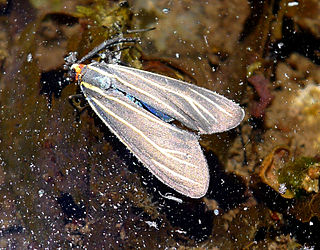
The shark is a moth of the family Noctuidae. The species was first described by Carl Linnaeus in his landmark 1758 10th edition of Systema Naturae.

The Ctenuchina are a subtribe of moths in the family Erebidae. These moths are diurnal, meaning they fly during the day. Their coloration is similar to that of certain beetles and wasps that predators avoid.

The nine-spotted moth or yellow belted burnet is a moth in the family Erebidae. The species was first described by Carl Linnaeus in his 1758 10th edition of Systema Naturae.

Ctenucha is a genus of moths in the family Erebidae.

Cisseps fulvicollis, the yellow-collared scape moth, is a species of the family Erebidae and subfamily Arctiinae. It was described by Jacob Hübner in 1818.

Esperia sulphurella, also known as the sulphur tubic, is a species of gelechioid moth in the family Oecophoridae. It is native to Europe, but has been introduced in California.

Achyra rantalis, the garden webworm, is a moth of the family Crambidae described by Achille Guenée in 1854. It is found in North America, where it has been recorded from Maine to southern Quebec and Ontario, south to Florida and Mexico. It has also been recorded from Iowa, Colorado, California and the West Indies. Its habitat consists of fields and gardens.

Ctenucha virginica, the Virginia ctenucha, is a moth of the family Erebidae. The species was first described by Eugenius Johann Christoph Esper in 1794.

Scopula junctaria, the simple wave, is a moth of the family Geometridae. The species was first described by Francis Walker in 1861. It is found in the whole of Canada and the northern United States, south to Maryland, Arizona, and California.

Stigmella salicis is a moth of the family Nepticulidae which is found in Europe. It was first described by the English entomologist, Henry Stainton in 1854. The type locality is from England.

Ctenucha brunnea, the brown ctenucha or brown-winged ctenucha, is a moth of the family Erebidae. The species was first described by Richard Harper Stretch in 1872. It is a diurnal moth found in the US from central to southern coastal California. North of that, it is replaced by Ctenucha multifaria.
Ctenucha quadricolor is a moth of the family Erebidae. It was described by Francis Walker in 1866. It is found on Jamaica.
Ctenucha devisum is a moth of the family Erebidae. It was described by Francis Walker in 1856. It is found in São Paulo in Brazil and in Argentina.
Ctenucha rubriceps is a moth of the family Erebidae. It was described by Francis Walker in 1854. It is found in Mexico, Guatemala, Costa Rica, Colombia, Venezuela, Brazil, Argentina and Uruguay.

Ctenucha rubroscapus, the red-shouldered ctenucha moth, is a moth of the family Erebidae. It was described by Édouard Ménétries in 1857. It is found in western North America, where it is limited to low elevations west of the Cascade Mountains, south of Chehalis in Washington. The habitat consists of coastal grasslands adjacent to the ocean, as well as wet boggy meadows and wet prairie.
Ctenucha ruficeps is a moth of the family Erebidae. It was described by Francis Walker in 1854. It is found in Mexico.
Ctenucha semistria is a moth of the family Erebidae. It was described by Francis Walker in 1854. It is found in Brazil.

Ctenucha venosa, the veined ctenucha moth, is a moth of the family Erebidae. It was described by Francis Walker in 1854. It is found in the US from southern Nevada and Arizona to Colorado, Kansas, Oklahoma and Texas, as well as in Mexico, Guatemala, Panama and Venezuela.

Eudulophasia invaria is a species of moth in the family Geometridae first described by Francis Walker in 1854.

Uresiphita reversalis, the genista broom moth or sophora worm, is a moth in the family Crambidae. It was described by Achille Guenée in 1854. U. reversalis was probably native to Mexico before spreading north and becoming established in Los Angeles by 1930 and the San Francisco Bay Area by 1980. It has since been recorded across the United States and in Cuba, Bermuda, Puerto Rico and Jamaica. Both adults and caterpillars are aposematic.













